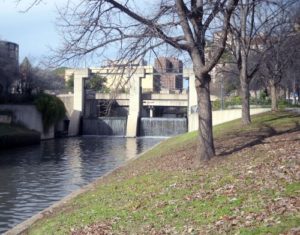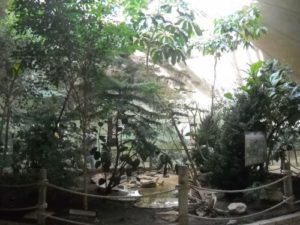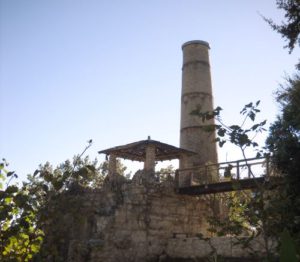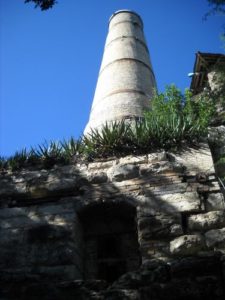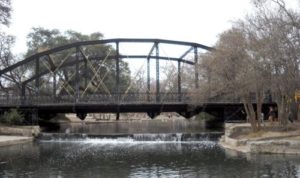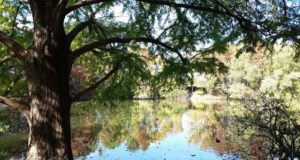This is going to be a twothree (see note below)-part post. The first part will cover the Witte Museum as I have visited it in the past and what I saw during my recent visit on June 21. Then, once the renovations to the museum are finished (which is projected to be sometime in early 2017), I will return and take new photos and do a writeup of that visit.
I’m trying to remember the first time I went to the Witte Museum. Fairly soon after we moved to Texas, my now-ex and I attended a wedding there, but I think that was our second visit, or maybe our third. I cut my teeth on world-class museums like the Field Museum of Natural History and the Museum of Science and Industry in Chicago, so the Witte was kind of underwhelming at first. Charming, in a sort of small-town way. My now-ex and I were particularly nonplussed by the selection of longhorn furniture (as in made from the horns of longhorn cattle, not furniture that supports the University of Texas at Austin Longhorns sports teams).
The entrance to the Witte Museum used to have a fountain and an elephant statue from the now-no-longer-extant Hertzberg Circus Museum in front of it. Flanking the doors (though a ways away) were two statues, “Mother and Child” and “Father and Child” by Charles Umlauf. I think there was also a third Umlauf sculpture somewhere on the property as well.
There was one dinosaur, as I recall, a triceratops, I think. This was kind of a disappointment, as this area had lots of dinosaurs back in those days. There are dinosaur tracks at Government Canyon State Natural Area and also some were found along the spillway for Lake Boerne (only one, maybe two, of the lakes of Texas are natural lakes — the rest are man-made). Seems like they could have acquired some more local species of dinosaur.
Quite a lot of the first floor of the museum was taken up with the special exhibit area, which has an extra charge in addition to the admission fee (that was hard to type at 7:00 in the morning!), and most of the rest of the floor was taken up with a display on the fauna of Texas, including some taxidermy animals. There was also a room that had live exhibits — tarantula, snakes, and so forth. The Witte had a coterie of prairie dogs, and a bee colony that had access to the outside.
Upstairs, as I recall, was primarily human history. There was a small exhibit on Ancient Egypt (for Ancient Egypt, back then, you’d be better off at the San Antonio Museum of Art) and some information on native cultures and the stone-aged people of Texas. There was also a room of artifacts from more recent Texas history (and this is where the aforementioned longhorn furniture used to stand).
I’m now about 500 words into this. Maybe I’ll turn the Witte Museum into a series of three posts. Because I’m still not entirely done with the layout of the museum before the renovations started.
At the back of the first floor of the museum was another temporary exhibit space — this one for free exhibits (mostly of photographs, posters, that sort of thing, though I think that may have been where I saw the display of butterflies and moths on one visit). I think our first visit was because I was on a historical photograph kick and someone mentioned that they were having a display of historical photographs at the Witte. Actually, if I recall, the person said, “There are historical photographs at the Witte,” and so I thought at first that it was a permanent thing. I was very disappointed to find that it was temporary.
At the back of that exhibit room there were several doors leading outside. There also used to be doors outside from somewhere in the vicinity of the room with the prairie dogs and bees. Out back of the museum there were a variety of historic structures including a limestone house, the studio of the artist Julian Onderdonk, and the home of José Antonio Navarro. There is also a replica log cabin constructed in 1939 by the National Youth Administration which, I guess, makes it historical, just in a different way from the others.
Way off in the southeasternmost corner of the museum’s property was the HEB Science Treehouse. The Science Treehouse focused largely on physics, since that’s a pretty easy thing to do in a museum — there were exhibits on pulleys, for example, and a whole room of various musical instruments to demonstrate acoustics (you would not believe what I had to go through to find that word!). There was also a section on ecology of the San Antonio River (which flows right past the museum) and I think there was a meteorology section as well. Outside the treehouse was an assortment of water-related activities, including an Archimedes Screw.
For the last part of the older Witte, I’m going to have to take you back farther in time, to the early 20th Century. A Mexican artist named Dionicio Rodriguez mastered a technique that he called “faux bois,” which is making cement look like wood. You can see his work all over the city. He made a bridge in Brackenridge Park and several features at the nearby Miraflores estate (speaking of things I need to talk about later). There are a number of other examples of his work throughout the city. When Rodriguez died in 1955, it was expected that the secret had died with him. However, another local artist, Carlos Cortés claims that Rodriguez taught the technique to his family and they passed it down to him. Either way, Cortés has been making faux bois sculptures throughout the area. As I write this, Cortés has just recently been sent to prison for a year for tax evasion.
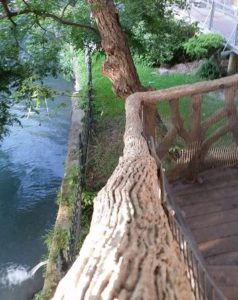
Well, tax evader or not, Cortés built what is one of my favorite parts of the Witte Museum, the Little Treehouse, a faux bois, well, treehouse, that has educational signage on the wildlife of the region. I generally go out through the door on the, I think it’s the second, floor of the HEB treehouse and walk the bridge across to the top of the Little Treehouse then walk down from there.
Much of the Witte is handicap accessible. Some of the historical buildings have stairs and, of course, there is no way to get a wheelchair down the stairs of the Little Treehouse. The bridge across is stable, though I hate to admit that it totally slipped my mind to measure the width to see if a wheelchair would have room to make it across.


